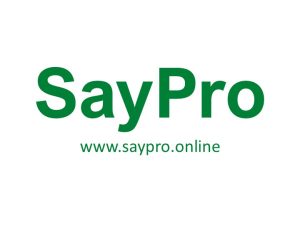Your cart is currently empty!
SayPro Collaboration with Government Representatives:Meet with government stakeholders to gather feedback on the programs. Discuss the success of the collaboration and any areas of improvement to be incorporated in future initiatives
SayPro is a Global Solutions Provider working with Individuals, Governments, Corporate Businesses, Municipalities, International Institutions. SayPro works across various Industries, Sectors providing wide range of solutions.
Email: info@saypro.online Call/WhatsApp: Use Chat Button 👇

SayPro Collaboration with Government Representatives:
Introduction: SayPro’s partnership with government stakeholders is a key element in shaping the success of the programs they work on. By regularly meeting with government representatives, SayPro aims to ensure that their initiatives align with public policy goals, address community needs, and promote effective outcomes. These meetings provide an opportunity to gather valuable feedback, celebrate successes, and identify areas for improvement. This collaborative approach helps SayPro refine its strategies and develop more impactful programs that serve both governmental objectives and the community at large.
Purpose of Collaboration:
The primary goal of SayPro’s collaboration with government representatives is to foster a mutually beneficial relationship. This ensures that programs are not only designed with public input and needs in mind but also that they align with the priorities of government stakeholders. The feedback sessions focus on:
- Program Effectiveness: Evaluating whether the implemented programs are meeting the objectives set by both SayPro and the government.
- Feedback from Beneficiaries: Gathering input on how well the programs serve the intended beneficiaries, including local communities, businesses, or other government sectors.
- Identification of Challenges: Understanding challenges or obstacles faced during program execution and how they can be addressed in future iterations.
- Sustainability: Ensuring that government stakeholders are satisfied with the long-term sustainability of programs initiated by SayPro and whether they can be scaled or modified for wider impact.
Key Areas of Discussion:
- Program Success: In every meeting, one of the core discussion points is the success of the program. SayPro presents data, case studies, and success stories from the ongoing initiatives to demonstrate the tangible outcomes achieved. This can include:
- Improved service delivery to communities
- Economic benefits such as job creation or business growth
- Increased access to services or infrastructure improvements
- Positive feedback from the public or other key stakeholders involved in the program
- Challenges and Areas for Improvement: No program is without its challenges, and it’s crucial for SayPro to engage in open discussions with government stakeholders about any obstacles that arose during the execution phase. Some common challenges could include:
- Bureaucratic delays or administrative hurdles that slowed progress
- Misalignment between initial goals and real-world outcomes
- Lack of sufficient resources or training for key staff members
- Limited engagement from the community or target beneficiaries
- Innovative Solutions and Future Strategies: Government representatives often bring innovative ideas or potential solutions to the table, especially if they have seen what has worked in other areas. In these meetings, SayPro and government stakeholders can brainstorm together on:
- New technologies or methodologies that could be incorporated into the programs
- Partnerships with other government agencies or non-governmental organizations (NGOs) to expand the program’s reach
- Policy recommendations to better support the program’s goals
- Feedback from Communities: Government stakeholders often have close ties with the communities SayPro serves, which means they can provide invaluable insights into how the program is being received on the ground. Feedback from local government offices, community leaders, or public representatives helps SayPro:
- Understand the needs and priorities of the community
- Identify gaps or areas where the program has not fully addressed local concerns
- Modify outreach and communication strategies to increase engagement and participation
- Build stronger relationships with the community through trust and transparency
Action Plan for Incorporating Feedback:
Based on the feedback gathered from government stakeholders, SayPro develops an action plan to incorporate the suggestions, improvements, and ideas discussed during the meetings. This action plan typically includes:
- Immediate Changes: Short-term modifications to the program, such as adjustments in the implementation process, additional resources, or changes to the communication strategy. These improvements can often be rolled out quickly to address any immediate concerns.
- Medium-Term Goals: Areas that require more time to address, such as training new staff, revising policies, or piloting new features in the program. SayPro outlines a timeline for these adjustments and provides regular progress updates to government representatives.
- Long-Term Vision: Long-term strategic goals, such as scaling the program, securing additional funding, or working toward systemic change within communities. This may involve drafting policy proposals, securing additional partnerships, or seeking further government support for expansion.
Conclusion:
Regular meetings and collaboration between SayPro and government representatives play a crucial role in ensuring that programs remain relevant, impactful, and aligned with both governmental objectives and community needs. These engagements foster a transparent and accountable relationship, allowing for continuous improvement and innovation. By discussing successes, challenges, and areas for improvement, SayPro and government stakeholders can build upon the foundation of their partnership, leading to more effective and sustainable programs in the future.
Leave a Reply